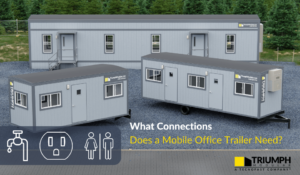Modular classrooms are beneficial for schools and the education sector in many different ways. They offer cost predictability, faster speed to occupancy, and much more.
However, one benefit we want to highlight is their environmental impact—choosing modular classrooms over traditionally-built classrooms can offer many green benefits.
So, what makes modular classrooms a green option?
Let’s dive into four factors that contribute to green modular classrooms.
1. Less On-Site Waste
One study from Archdesk produced some interesting findings about construction industry waste. The construction industry contributes:
- 23% of air pollution
- 40% of drinking water pollution
- 50% of landfill waste
A significant amount of this waste comes from damages and unused materials.
For example, on a traditional construction site, adverse weather conditions can damage materials on-site. If there aren’t any procedures in place to protect certain at-risk materials, weather conditions can create more waste and add to the landfill problem.
Instead, with controlled factory environments provided by modular construction, there’s far less risk for damaged materials—procedures are in place to keep waste to a minimum.
If a modular classroom is leased, most companies will remove the classroom at the end of the lease and leave behind no on-campus waste. The materials to create the classroom don’t need to be disposed of, like with traditional construction. Instead, classrooms are rolled out on a trailer hitch, just as they were delivered.
2. Lower Emissions
The modular construction process primarily takes place off-site in a controlled factory environment.
As a result, there is a reduced need for on-site equipment, such as concrete mixers, cranes, and bulldozers, which typically emit significant amounts of greenhouse gasses during traditional construction.
Fewer on-site emissions mean a smaller carbon footprint associated with the construction phase.
Lowering the on-site emissions also contributes to a lower site impact. If construction needs to take place while students are still learning, choosing modular classrooms means less time with large machinery on-site polluting the air around them.
There’s still some on-site work that needs to be done, but choosing modular allows foundational work and site work to be performed at the same time—drastically reducing on-site emissions.
3. Material Recycling
Modular construction factories have practices in place to reuse, repurpose, and recycle unused materials.
How is this possible?
For the most part, modules used in modular classrooms are all very similar to each other, using similar materials in their builds. There are custom builds based on size and aesthetic, but the materials used in a build can be easily used in another.
This helps create a cohesive process where very few materials are wasted.
Compare this to traditional construction methods, where waste is plentiful—something we’ll get into with the final point.
4. Repurposing and Reusing
Modular classrooms are adaptable—if a school’s needs change, they can be repurposed, extending their lifespan and reducing the need for new construction — for example, classrooms being converted to offices or vice versa.
The flexibility of modular classrooms reduces the demand for new building materials and minimizes the impact associated with demolition and disposal.
Learn More About Green Modular Classrooms In Our Guide
Looking to learn more about what makes modular classrooms green (along with other important information)?
Triumph Modular’s new ebook, the Guide to Modular Classrooms, has everything you need to know about modular classrooms, from green building practices to costs and much more.
Download our Modular Classroom Guide today!




